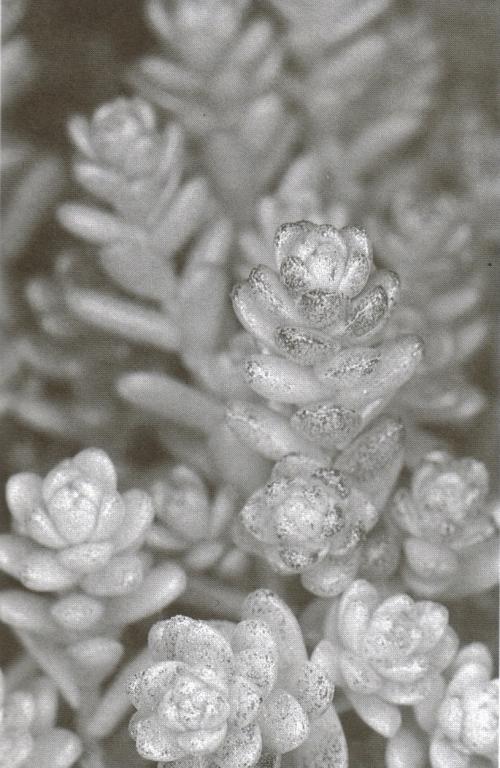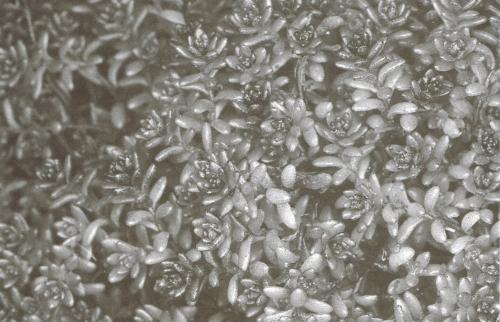JAPONICUM ssp. ORYZIFOLIUM R.Stephenson
Synonyms :
Sedum oryzifolium Makino (1891)
Sedum uniflorum var. pumilum H. Ohba (2001)
Distribution : Korea, Japan (Kyushu, Shikoku, Pacific side of Honshu, Ryukyu), on rocks near the coast.
Description (by 't Hart & Bleij in IHSP, 2003) :
Differs from ssp. uniflorum :
Without subterranean tubers.
Leaves clustered in the upper stem parts, linear-elliptic to linear-obovate, 4 - 7 mm.
Inflorescences : Flowering branches erect or with short decumbent base, inflorescences cymes with 3 cincinni.
Ray Stephenson (Sedum, Cultivated Stonecrops, 1994, pp 163 -165) :
Common name : Taitōgome
Clones of Sedum oryzifolium can be difficult to separate from the range of S. japonicum [= S. japonicum ssp. japonicum] clones in cultivation. At times differences seem too meager to be considered, and the plants seem to be one and the same species. Work by Uhl and Moran (1972), however, showed them to be cytologically distinct. Sedum oryzifolium has n = 10 ; S. japonicum has n = 19. Tomitara Makino (1891, 2) said of S. oryzifolium, "This plant grows near the sea; it resembles very much S. japonicum, but differs from it by its erect-patent follicles, shorter leaves, long creeping stems, sterile end of the main stem and flowering time." Not all these points are particularly helpful:
• "This plant grows near the sea" is most helpful to field botanists or enthusiasts who encounter plants in the wild, for Sedum japonicum is associated with hilly terrain, but it does not help a gardener to identify plants in the garden with any certainty.
• "Erect-patent follicles" is a contradiction in terms that refers to carpels as being only somewhat spreading. Sedum japonicum has widely spreading carpels, but differences . between its carpels and those of S. oryzifolium are not particularly marked.
• "Shorter leaves" is a description with which I disagree completely. A giant form of Sedum oryzifolium from Jogashima Island has longer leaves than S. japonicum. In general, leaves of S. oryzifolium are more succulent, thicker, and wider than those of S. japonicum, and therefore they appear shorter with respect to girth.
• "Long, creeping stems" is probably the most useful aid to identification, but stems are only long and creeping after several seasons. Sedum japonicum tends to die back to its origin, though broken-off pièces root in the vicinity of the parent. Sedum oryzifolium, on the other hand, creeps, and roots as it creeps. After many seasons, its stems can be exceptionally long, with tufts rising at intervals as plants spread and form carpets.
• "Sterile end of the main stem" is fairly helpful with mature plants, but not with young cuttings. Sedum japonicum tends to flower at all stem tips, and as inflorescences die back, new tufts are revealed below. Sedum oryzifolium, if a large plant, has lots of sterile stems.
• "Flowering time" for Sedum oryzifolium is earlier in the wild, but this is most probably due to the species low-altitude, maritime habitat. In cultivation there is no marked difference between flowering time of the two species.
Upright, tufted stems carrying loose, spirally arranged, spurred leaves make Sedum oryzifolium very similar in appearance to some of the yellower forms of S. album from Europe. Both species change remarkably with site, although, at least three very distinct clones of S. oryzifolium are in cultivation.
Habitat : This stonecrop is indigenous to coastal rocks of southern Honshu, Shikoku, and Kyushu islands of Japan and neighboring offshore Pacific islands.
Main points of distinction : Sedum oryzifolium sometimes produces eroded petals, an odd feature for the genus. Two- or three-branched inflorescences carry flowers with fairly upright, linear, terete sepals of equal length. The name suggests that leaves are like grains of rice. Compared to other Far Eastern species this is a reasonable guide, but leaves of some occidental species resemble rice grains more accurately.
Variation : A particularly eye-catching form from Jogashima Island off the Miura Peninsula is a large, sturdy, upright plant that tinges red in summer, especially on leaf margins. Looking at the blush closely, it is made up of a myriad of tiny wine red dots. A form from Niijimar Island (160 km (100 miles) south-southwest of Tokyo Bay) is very similar.

An exceptionally minute form, which may in fact be a tiny form of Sedum japonicum ssp. uniflorum (common name: Kogome-mannengusa), a closely related species, forms a dense mound of long stems and tiny leaves, which together turn bronze then wine red in a sunny spot. Flowers are often produced singly or in small numbers and again are often eroded. This form is far more common in Japan than elsewhere and is usually referred to in cultivation as S. oryzifolium 'Tiny Form'.

If grown indoors, all forms become pale, creeping plants without upright tufts, and they lose their individual identity.
Horticulture : Bright, pea-green leaves are very striking and similar, in many respects, to Sedum acre, except for shape. No forms of S. oryzifolium, unfortunately, are particularly hardy, but all are recommended for alpine collections despite their low-altitude origins. In drought conditions, plants sometimes act as annuals. In warm temperate lands, this species would be perfect for ground cover as it is dense and highly colorful. It is also ideal for growing between paving stones.